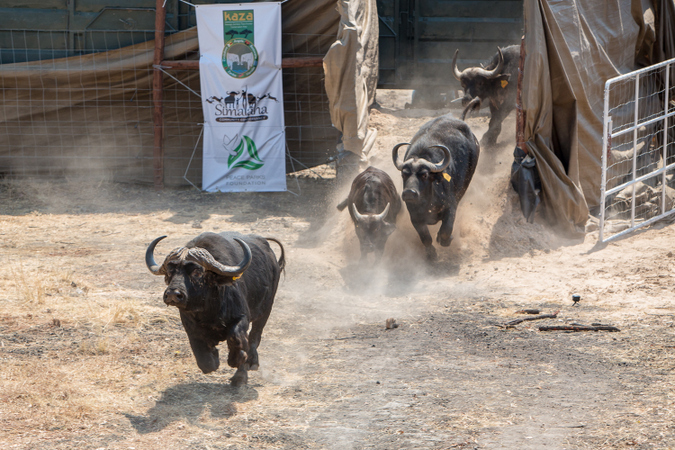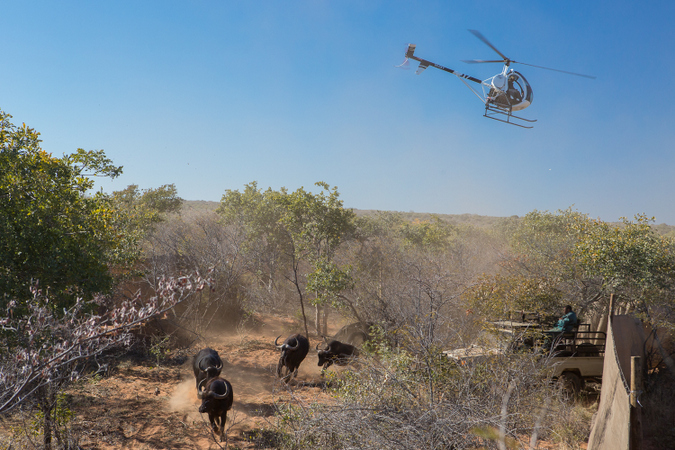
Media release from Peace Parks Foundation
On 23 August 2018, the first 90 of 200 African buffalo were presented to the communities of Senior Chief Inyambo Yeta and Deputy Chief Joyce Sekute to further develop the Simalaha Community Conservancy, which forms a vital Zambian component of the Kavango Zambezi Transfrontier Conservation Area, or KAZA as it is known.
KAZA is the biggest terrestrial cross-border conservation system in the world – connecting 37 protected areas across Angola, Botswana, Namibia, Zambia and Zimbabwe. The aim is to preserve large ecosystems across borders and re-establish corridors that allow the free movement of wildlife along ancient migratory routes.
Dr Nyambe Nyambe, Executive Director of the KAZA Secretariat, stated: “Our vision is to establish KAZA as a world-class transfrontier conservation and tourism destination. Within this, socio-economic development is critical. This can only be done by increasing sustainable livelihood and development opportunities for the local communities, such as those in Simalaha, who often bear the ‘cost’ of living with wildlife.”
The Simalaha Community Conservancy comprises 180,000 ha of communal land and lies within one of six key wildlife dispersal areas in KAZA, namely the Chobe Zambezi dispersal area that reaches from Chobe National Park in Botswana to Kafue National Park in Zambia. The Conservancy was established in 2012 to ensure viable natural resource management and support wildlife conservation; to address basic human rights of the Sesheke and Sekhute people, and develop alternative models for income generation for these two communities.
Income from wildlife management was identified as a critical component of the Conservancy and in 2013 a wildlife sanctuary measuring 24,000 ha was established as part of Simalaha. Through the active reintroduction of wildlife that used to occur in the area, and with the addition of the buffalo, the sanctuary now boasts eight different species totalling more than 1,600 animals.

The buffalo were purchased from the Waterberg Plateau Park in Namibia, which had exceeded its carrying capacity for the species. In July, 120 buffalo were captured and spent 30-days in a quarantine facility in Namibia where they were tested and monitored for any signs of foot-and-mouth disease. Ninety of the now certified disease-free animals were released into a 2,500-ha fenced section within Simalaha’s wildlife sanctuary, with the remaining 30 to be brought in next week. An additional 80 will be captured and transported to Simalaha in September, bringing the total to 200 buffalo. Providing disease-free buffalo to Simalaha was crucial, as this member of Africa’s popular Big 5 will not only boost the tourism offering, but will also generate income through the sale of the offspring of the buffalo to other areas in Zambia.
Senior Chief Inyambo Yeta highlighted the fact that the totem animal for his Chiefdom was the buffalo. In years gone by, his chiefdom was responsible for defending their territory from invasion from neighbouring communities and through their efforts were given the totem animal of the buffalo, renowned for its fierceness and impressive defensive skills.
“The buffalo are back! The buffalo are back! I never thought that I would see this happen in my lifetime!” exclaimed the Chief.
The acquisition of the buffalo was made possible by Peace Parks Foundation through the support of its generous donors. The Foundation has been providing the Sesheke and Sekute chiefdoms with technical and financial support since the inception of the Conservancy.
Speaking at the ceremonial release of the buffalo, Peace Parks Foundation CEO, Werner Myburgh said: “These buffalo represent intrinsic economic value and improved livelihoods for people living in the Conservancy and demonstrate our continued commitment to the Simalaha initiative. Simalaha serves as a model of success for community-based conservation engagement and we are continuously inspired by the community’s devotion to protecting the region’s natural and cultural heritage.”

Simalaha seeks not only to conserve wildlife but also to improve the social, economic and environmental circumstances of the communities that host the Conservancy. In this regard, important milestones have been achieved over the past five years which include the training of 22 community wildlife scouts, known as Village Scouts, to protect the animals in the wildlife sanctuary; provision of solar lighting to key communal facilities; and the construction of houses for teachers at a local school. In addition, more than 1 200 farmers have been provided with seeds and trained in Conservation Agriculture methods to improve their yield with less impact on the environment, with many now producing surplus crops to sell. In partnership with Grounded, a process has started to create access to markets for the excess produce.
“We want to thank our partners, the Department of National Parks and Wildlife of Zambia and the Namibian Ministry of Environment and Tourism as well as the kind and continued support of our donors, in particular the MAVA Foundation for Nature, Pamela and Neville Isdell, the COmON Foundation, Coffr Foundation, the Swedish and Dutch Postcode Lotteries and KfW for helping to make Simalaha the success it is today”, concluded Mr Myburgh.
WATCH: The first 90 buffalo were released to welcoming cheers from the community
To comment on this story: Login (or sign up) to our app here - it's a troll-free safe place 🙂.![]()








